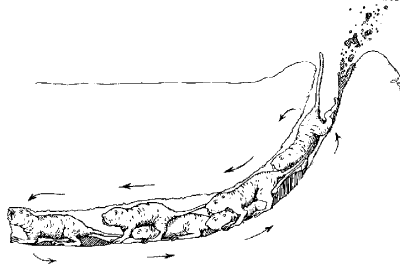 |
Science Frontiers ONLINE No. 106: Jul-Aug 1996 |
|
|
It's a mole-rat, jim, but not as we know it
Naked mole rats are the most social of all the mammals. They live in underground colonies with a social structure like that of ants and termites. There are castes of workers, and only the queen, an oversized female, breeds. Naked mole rats are also intensely xenophobic; they avoid or fight with other mole-rat colonies. But such tightly closed societies lead to inbreeding with all its deleterious effects. For naked mole rats to survive over the long term, a biological solution to the inbreeding problem had to be found.
The response of the species to this threat is the occasional production of a "dispersive morph." The largest and most successful colonies produce -- somehow -- a larger-than-normal individual, almost always a male, that is fuelled with extra fat and possesses a yen to travel. He is disinclined to mate with the resident queen, preferring to leave the colony for amorous adventure elsewhere. Thus, intercolony gene flow is established.
(Gee, Henry; "It's a Mole-Rat, Jim, But Not As We Know It," Nature, 380:584, 1996. O'Riain, M. Justin, et al; "A Dispersive Morph in the Naked Mole-Rat," Nature, 380:619, 1996)
Comment. Of course, the naked-mole-rat colony, even when thought of as a "superorganism," cannot perceive the future consequences of inbreeding. The invention of a "dispersive morph," according to evolutionists, has to come from a sequence of random mutations that over time create a special individual, specially fuelled and with abnormal proclivities. Those mole-rat colonies not favored with this sequence of mutations were (are?) eliminated by natural selection. This all seems a lot to ask of a random process.
Reference. To learn more about naked mole-rats and some of their close relatives, see our catalogs: Biological Anomalies: Mammals I and II. These books are described here.
| Naked mole-rat colonies are highly cooperative. Here, an excavating team digs a tunnel using an endless-chain technique. Mole rats below move backwards pushing dirt back and out. They return by crawling forward over the backs of the dirt-pushers. (See BMB25 in Mammals I.) | 
|